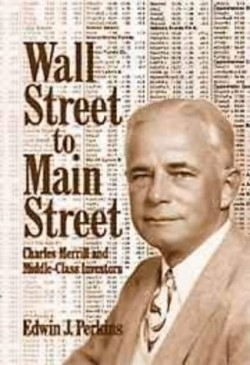Wall Street to Main Street
Charles Merrill and Middle-Class Investors
What do groceries have to do with the success of Merrill Lynch, the world’s largest brokerage and investment firm? As an expert on the historical development of American financial services from colonial times to the twentieth century, Perkins, Professor of History at the University of Southern California, explains this interesting paradox in his biography of Charles Merrill (1885-1956).
Merrill’s early life is reviewed as being very significant to his later years, as the devotion to his mother and father and the networking of business among old friends had a lingering influence. There are only cursory references to his three marriages and divorces. Since he seemed to have a dual personality, one that failed domestically and one that begot business success, emphasis is placed on the latter, for he possessed an incredible foresight with regard to the development of capital markets and what products and services would prove successful.
Sometime during his first year in New York, while working for a textile manufacturer, Merrill met Edward Lynch, his future business partner. Their personalities were vastly different, yet proved to be complementary; Merrill gracious and outgoing, Lynch was blunt and assertive. When Merrill, shortly thereafter entered the securities business, he hired Lynch and they learned the function of providing capital to companies through the underwriting and syndication of stocks and bonds.
Chain stores that retailed groceries were growing in popularity by virtue of their lower prices as a result of purchasing inventories in bulk. Early on, Merrill was able to underwrite a stock offering for Safeway Stores, retaining a block of stock for himself, and later acquiring a controlling amount that was eventually valued in the millions. This accumulation of capital was used as a springboard for the entry of Merrill Lynch into the retail brokerage business.
At the time there were no models in the investment brokerage field. Consequently, many practices that Merrill Lynch adopted were original and unprecedented. The goal at Safeway had been to generate a high volume of fine quality products with wide distribution, attractive to all income levels. Merrill came to believe the same principles could be applied to the brokerage services and that the customer base could encompass the middle class, maintained by a string of branch offices.
The story goes on to take this concept to astronomical results with all the intriguing details, written in a style that does justice to the author’s extensive research. Once in a while there is some redundancy, but it does not detract from a first class portrayal of a most innovative entrepreneur. A prospective audience for this book will be found readily among the many people with business pursuits; business practices of one trade can translate into the success of another.
Reviewed by
Harry O. Lang Jr.
Disclosure: This article is not an endorsement, but a review. The publisher of this book provided free copies of the book to have their book reviewed by a professional reviewer. No fee was paid by the publisher for this review. Foreword Reviews only recommends books that we love. Foreword Magazine, Inc. is disclosing this in accordance with the Federal Trade Commission’s 16 CFR, Part 255.

